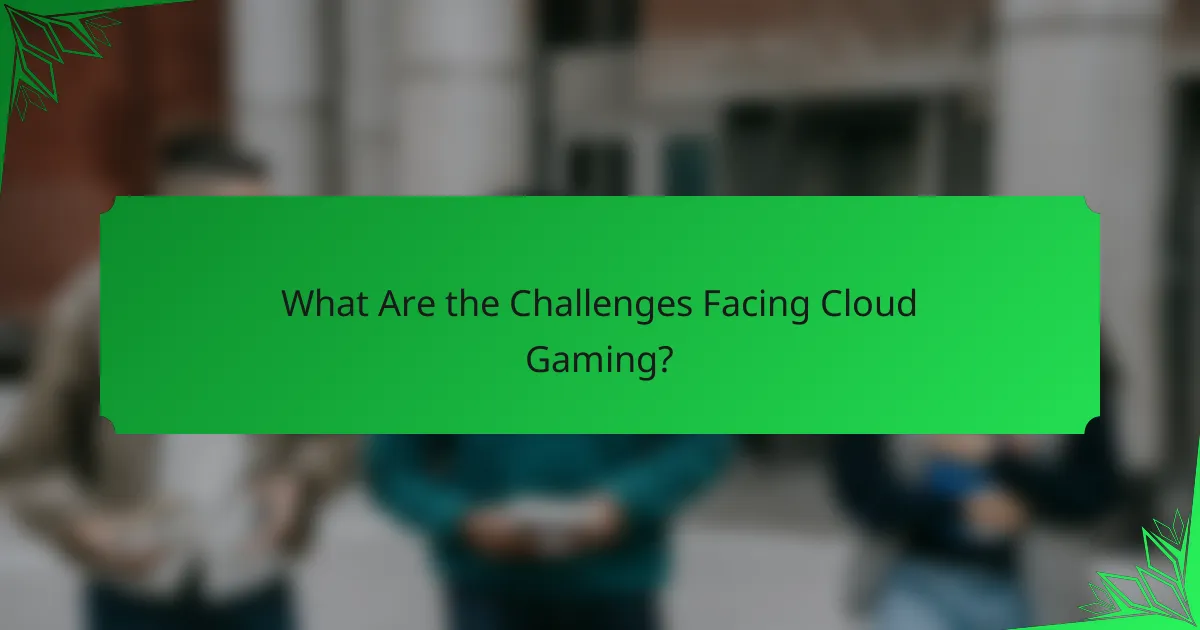Cloud gaming technologies are rapidly evolving, driven by innovations such as real-time rendering and AI-driven game optimization. These advancements not only improve performance and accessibility but also enhance the overall quality of gaming experiences. With varying platforms offering different performance levels, game libraries, and subscription models, understanding these factors is crucial for gamers seeking the best service tailored to their needs.

What Are the Key Innovations in Cloud Gaming Technologies?
Key innovations in cloud gaming technologies include advancements in real-time rendering, AI-driven game optimization, cross-platform compatibility, edge computing integration, and support for virtual reality. These developments enhance user experience by improving performance, accessibility, and the overall quality of gaming.
Real-time rendering advancements
Real-time rendering advancements allow games to be processed and displayed with minimal latency, enhancing the visual experience for players. Techniques such as ray tracing and adaptive resolution scaling are becoming more common, enabling more realistic graphics without requiring extensive local hardware.
These innovations can significantly reduce the time it takes for a game to respond to player actions, often achieving response times in the low tens of milliseconds. This is crucial for fast-paced games where every millisecond counts.
AI-driven game optimization
AI-driven game optimization uses machine learning algorithms to adjust game settings dynamically based on player behavior and network conditions. This ensures smoother gameplay by optimizing graphics quality and performance in real-time, adapting to the capabilities of the user’s device and internet connection.
For example, AI can lower graphical fidelity during peak usage times to maintain a stable frame rate, allowing players to enjoy a seamless experience even on less powerful devices. This technology is particularly beneficial for mobile gamers or those with limited bandwidth.
Cross-platform compatibility
Cross-platform compatibility enables gamers to play together regardless of the device they are using, whether it’s a console, PC, or mobile device. This innovation breaks down barriers and fosters a larger, more inclusive gaming community.
Many cloud gaming services now support this feature, allowing players to switch between devices without losing progress. This flexibility is appealing to users who want to game on the go or share experiences with friends on different platforms.
Edge computing integration
Edge computing integration reduces latency by processing data closer to the user, rather than relying solely on centralized servers. This is particularly important for cloud gaming, where delays can disrupt gameplay and diminish the user experience.
By utilizing edge servers located nearer to players, cloud gaming services can achieve response times in the single-digit milliseconds range, making games feel more responsive and immersive. This technology is increasingly being adopted in urban areas with high player density.
Virtual reality support
Virtual reality (VR) support in cloud gaming allows players to experience immersive environments without the need for high-end local hardware. By streaming VR content from powerful servers, users can enjoy high-quality graphics and interactive gameplay on compatible devices.
As VR technology evolves, cloud gaming platforms are beginning to offer more titles that leverage these capabilities. However, users should ensure they have a stable and fast internet connection, ideally with speeds above 25 Mbps, to fully enjoy the experience without interruptions.

How Do Cloud Gaming Platforms Compare?
Cloud gaming platforms vary significantly in terms of performance, game library, and subscription models. Understanding these differences can help users choose the right service based on their gaming preferences and internet capabilities.
Google Stadia vs. NVIDIA GeForce NOW
Google Stadia and NVIDIA GeForce NOW both offer cloud gaming experiences but differ in their approach. Stadia operates on a subscription model with a library of games available for streaming, while GeForce NOW allows users to play games they already own on platforms like Steam or Epic Games Store.
Performance-wise, GeForce NOW often provides better graphics and lower latency due to its use of high-end NVIDIA GPUs. Stadia, however, aims for a more integrated experience with exclusive titles and seamless streaming across devices.
Xbox Cloud Gaming vs. PlayStation Now
Xbox Cloud Gaming, part of Xbox Game Pass Ultimate, provides access to a vast library of games for a monthly fee, allowing users to play on various devices. PlayStation Now, on the other hand, offers a similar subscription service but focuses more on older titles and a smaller selection of current games.
When comparing performance, Xbox Cloud Gaming generally delivers a smoother experience with lower latency, especially for newer titles. PlayStation Now’s strength lies in its extensive catalog of classic games, appealing to fans of legacy titles.
Amazon Luna vs. Shadow
Amazon Luna and Shadow cater to different gaming needs. Luna is a subscription-based service that offers a rotating selection of games, while Shadow provides a full Windows PC in the cloud, allowing users to install and play any game they own.
In terms of flexibility, Shadow is ideal for gamers who want to customize their experience and access a broader range of software. Luna, however, is more user-friendly for casual gamers looking for a straightforward way to play without the need for extensive setup.

What Are the Essential Features of Cloud Gaming?
Cloud gaming relies on several essential features that enhance the gaming experience. Key aspects include low latency performance, subscription models, game library diversity, and user interface design, all of which contribute to seamless gameplay and accessibility.
Low latency performance
Low latency performance is crucial for cloud gaming, as it directly affects the responsiveness of gameplay. Ideally, latency should be kept under 30 milliseconds to ensure a smooth experience, particularly for fast-paced games. High latency can lead to lag, making it difficult for players to react in real-time.
To achieve low latency, players should use a stable and fast internet connection, preferably wired, and choose servers that are geographically closer to them. Many cloud gaming services provide tools to test connection speed and latency before gameplay.
Subscription models
Subscription models are a popular feature in cloud gaming, allowing players to access a wide range of games for a monthly fee. These models can vary significantly, with some services offering all-you-can-play access while others charge per game or include in-game purchases.
When selecting a subscription service, consider the number of games available, the frequency of new titles added, and whether the service supports multiple devices. Popular options include Xbox Cloud Gaming and PlayStation Now, which provide extensive libraries for a flat monthly rate.
Game library diversity
Game library diversity is essential for attracting and retaining players in cloud gaming. A robust library includes various genres, from action and adventure to strategy and simulation, catering to different player preferences. The more diverse the library, the more likely players are to find games that interest them.
Many cloud gaming platforms regularly update their libraries with new releases and classic titles. Check for exclusive games or partnerships that may enhance the offering, as these can significantly impact your gaming experience.
User interface design
User interface design plays a vital role in the overall cloud gaming experience. A well-designed interface should be intuitive, allowing players to easily navigate through game libraries, settings, and features. Good design minimizes the learning curve and enhances user satisfaction.
Look for platforms that offer customizable interfaces, allowing users to arrange their game libraries according to personal preferences. Additionally, consider how well the interface performs across different devices, as seamless transitions between platforms can enhance the gaming experience.

What Are the Challenges Facing Cloud Gaming?
Cloud gaming faces several significant challenges that can impact user experience and accessibility. Key issues include internet bandwidth requirements, data privacy concerns, game ownership issues, and latency and lag problems.
Internet bandwidth requirements
Cloud gaming demands a stable and high-speed internet connection to deliver smooth gameplay. Typically, a minimum bandwidth of 15-25 Mbps is recommended for standard quality, while higher resolutions may require 50 Mbps or more.
Users in areas with limited internet infrastructure may experience difficulties, leading to interruptions or degraded performance. It’s essential to check your internet speed and consider upgrading your plan if necessary.
Data privacy concerns
Data privacy is a significant challenge in cloud gaming, as users often need to share personal information with service providers. This raises concerns about how data is stored, used, and protected against breaches.
Players should review the privacy policies of cloud gaming platforms to understand their data handling practices. Opting for services with strong encryption and transparent policies can help mitigate these risks.
Game ownership issues
In cloud gaming, ownership of games can be ambiguous, as players typically access titles through subscriptions rather than owning physical or digital copies. This means that if a service shuts down or a game is removed, players may lose access to their purchased content.
To navigate this, players should consider platforms that offer a mix of subscription and purchase options, ensuring they retain access to their favorite games even if subscription services change.
Latency and lag problems
Latency and lag are critical factors that can ruin the gaming experience in cloud environments. Even with a good internet connection, delays can occur due to data traveling to and from remote servers, resulting in a lag of tens to hundreds of milliseconds.
To minimize these issues, players should choose cloud gaming services with data centers close to their location and use wired connections instead of Wi-Fi when possible. Regularly testing and optimizing your network can also help improve performance.

How Is Cloud Gaming Evolving in North America?
Cloud gaming in North America is rapidly advancing, driven by technological innovations and increasing consumer interest. This evolution is marked by significant market growth, changing consumer behaviors, and improvements in regional infrastructure.
Market growth statistics
The cloud gaming market in North America has seen substantial growth, with estimates suggesting it could reach several billion USD in the coming years. This growth is fueled by the increasing availability of high-speed internet and the rise of subscription-based gaming services.
Analysts project that the market could expand at a compound annual growth rate (CAGR) of around 20-30% over the next few years, reflecting a strong shift towards digital gaming platforms. Major players like Google, Microsoft, and NVIDIA are investing heavily in this sector, further driving competition and innovation.
Consumer adoption trends
Consumer adoption of cloud gaming in North America is on the rise, with many gamers embracing the convenience of playing without the need for high-end hardware. Surveys indicate that a significant percentage of gamers are open to using cloud services, especially younger demographics who prioritize accessibility.
Subscription models are becoming increasingly popular, allowing users to access a wide library of games for a monthly fee. This trend is encouraging more casual gamers to try cloud gaming, as it reduces the upfront costs associated with traditional gaming setups.
Regional infrastructure developments
Improvements in internet infrastructure are crucial for the evolution of cloud gaming in North America. Many regions are upgrading to fiber-optic networks, which provide the low latency and high bandwidth necessary for seamless gaming experiences.
Additionally, companies are establishing data centers closer to major urban areas to minimize latency and enhance performance. These developments are essential for supporting the growing demand for cloud gaming services, ensuring that users can enjoy high-quality gameplay without interruptions.
